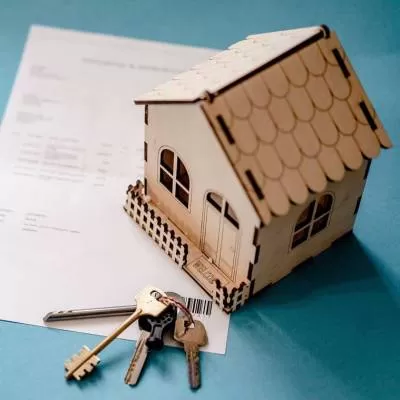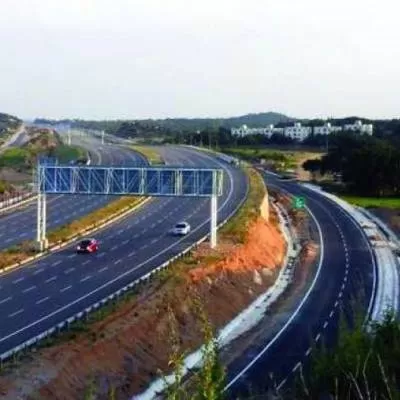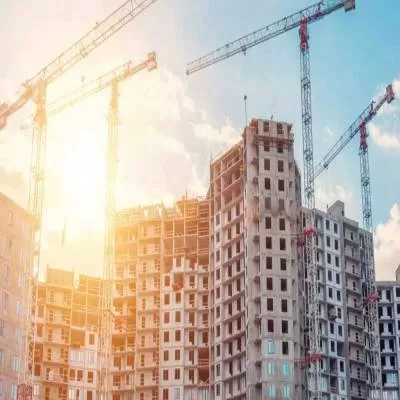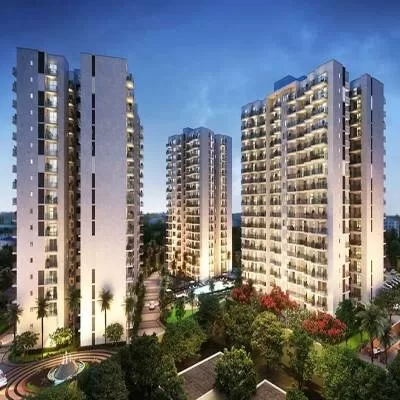- Home
- Real Estate
- Roofing Glories
Roofing Glories
Rajesh Maheshwari, Head-Technical Support (Coated Steel), Tata BlueScope Steel writes about the roofing material options available today.
A roof can be as basic as a means to keep the rain, heat or cold out. Further, it performs the functions of rainwater collection, day lighting, solar energy collection and supports insulation. It can also be a sign of prestige; many structures are defined or identified by their roofs. Today there are different materials used for roofing, many of which can accomplish all of the above. Choosing the right material — for repair or a new roof — requires an analysis of factors such as life, cost, solar reflectivity, fire resistance, wind resistance and ecological impact beside visual appearance.
Materials on the market
Materials available are both naturally occuring and manmade. The choices range from asphalt to clay tiles to metal, slate and wood, materials that are both naturally occurring and manmade. Of late, the trend has been to use engineered roofing materials. Here are your options (in alphabetical order):
Asbestos: Asbestos has a long lifespan and is fireproof and low in cost but its popularity is reducing owing to health concerns. Air-borne asbestos fibres accumulate in the lungs and may cause asbestosis, mesothelioma or lung cancer. Asbestos sheets are also prone to breakage during handling and usages. They require a heavier support structure for higher weight compared to metallic sheets. This results in increase in cost.
Asphalt: Asphalt as sheeting is composed of an inner core, usually of fibreglass or cellulose fibre, coated with asphalt on both sides and topped with a protective mineral aggregate. It can be treated with fire retardants and comes in different thicknesses. Asphalt roofing products are usually the least expensive but less durable over time. It is also a bad roofing option environmentally for lower life and high solid waste. Also, it causes air pollution during installation that is a health risk to installers.
Bamboo: Bamboo is a fast growing and renewable raw material resource. As a light building material, bamboo mat corrugated sheets display great thermal efficiency. They keep the interiors cool in summer and warm in winter and provide good sound insulation. Bamboo with polymeric materials is also present in sandwich panel form. However, the material is quite vulnerable to fire and has low resistance to fungal, mould and borer attack. It can only be used for high-pitched roofs.
Concrete: Concrete is the most used manmade material for building. It is a construction material composed of cement and one or more of other materials such as fly ash, slag cement, limestone, granite, sand, water and chemicals. To give it strength, it is reinforced with steel. Concrete has excellent wind and fire resistance and is also durable. However, when exposed to sea water, it is susceptible to its corrosive effects. Concrete has a very low coefficient of thermal expansion. But, if no provision is made for expansion, very large forces can be created, causing s in parts of the structure. It is not environment-friendly at site and post-usage because it has no reusability and causes high landfill. It is heavy, so supporting units and the floor need to be strong. Concrete buildings are not good for earthquake-prone areas and have limitations of usage in freeze or thaw areas. Long construction time also does not favour it.
Membrane: Also known as burnt-on roofing because it is flame-sealed, membrane roofing is used on flat or nearly flat roofs to prevent leaks and move water. This type of roofing resembles a large, shrink-wrap sheet covering the roof frame and under layment. The membrane is made from a variety of materials, ranging from rubber to thermoplastic. Membrane roofing is fairly durable and more common in commercial structures. Some common membrane types are EPDM (ethylene-propylene-diene-terpolymer membrane), CPE (chloro-polyethylene) and CSPE (chloro-sulfonated-polyethylene).
Metal: Metal sheets have a long life, great flexibility and are light, strong, quick to install, insect and mould resistant and relatively inexpensive (unless copper is used). For these features, metal sheets are the most preferred engineered building material. Although the initial cost of metal roof systems may be a bit higher than the cheapest alternative, its cost/benefit ratio over lifespan is superior to low-cost options. Metal roofing is available in a number of materials and configurations, which include aluminium, coated steel, copper and stainless steel. However, for roofing and walling, the choice is primarily of aluminium or coated steel. Aluminium has good corrosion resistance but is expensive and has a higher thermal expansion coefficient compared to coated steel. Another problem with aluminium sheeting is loosening at holes and removal under wind. Aluminium is extracted from its bauxite ore by a highly energy intensive process. Virgin aluminium has much higher embodied energy compared to aluminium with recycled content. Thicker aluminium is required for higher load bearing, which means a heavier solution. Further, the stiffness of steel is three times that of aluminium. Steel is one of the strongest, most durable and economically manufactured materials on earth. About 25 per cent of scrap material is recycled in the final steelmaking process and there’s typically only 2 per cent waste in construction versus 20 per cent waste in wood construction. Steel for roofing is usually coated with metallic coating. It is available plain or factory painted using various paint systems to give it a differential look and weathering properties.
Polycarbonate: Polycarbonate sheets are made of a polymer that can be shaped by different processes, which include injection moulding, blow moulding, extrusion and thermoforming. They have high light transmission and low coefficient of thermal expansion. Though lightweight and easy to handle and install, polycarbonate roof sheets are relatively costly. Thus, they are generally used to provide daylight solutions in industrial and commercial structures. Polycarbonate has poor scratch resistance and poor temperature control; it is cold in winter, hot in summer and noisy in the rains.
Slate: Natural slate has been in use for centuries. It is beautiful, long lasting and sheds ice and snow but is expensive and hard to install. Though it is resistant to rot, slate roofing materials can be easily broken when walked upon. Properly installed, a slate roof doesn’t require much maintenance and adds extra fire protection to the building. Slate cleaves into thin sheets, making it lighter than tiles, though heavier than steel sheets and other lighter options. It works better on a high slope for installation. Because of its cost and weight, which requires a strong structure to support it, slate is not often used these days.
Stone: Stone slab is an obsolete roofing material. Heavy stone slabs, 25-50 mm thick, were formerly used as roofing tiles. They require a heavyweight roof structure but their weight makes them storm-proof.
Tensile membrane: Tensile membrane or structure is a construction of elements carrying only tension and no compression or bending. It is low in mass as it uses fabrics rather than meshes or films. Cotton, polyester and nylon fabrics are used but deteriorate on exposure to pollution and UV radiation and lose their shape, as they are extremely plastic. For greater strength and environmental resistance, this fabric would be woven polyester cloth coated with PVC or fibreglass coated with PTFE (Teflon) or silicon.
Thatch: A traditional natural roofing material, thatch roofing is made of dry vegetation such as wheat straw, water reed and sedge. Synthetic straw (polythene) is an alternate. Used in both tropical and temperate climates, thatch is layered to shed water away from the inner roof and is versatile when it comes to covering an uneven roof. Low-cost, local vegetation thatch is still employed in developing countries. Thatch is a natural heat and acoustic insulator but its thickness decreases over time with surface erosion. Typically, a new layer has to be applied over the weathered surface a number of times. Though by nature, it is not prone to wind damage, thatch is associated with fire hazards and is prone to fungal attacks in warm, wet climates. Further, it is not suitable for a low slope roof.
Tile: Clay tiles are also called terracotta or Mangalore tiles. Concrete tiles, made from a mixture of cement and aggregate, are usually reinforced. Ceramic tiles have the highest cost - and long life - and are considered ‘recyclable’ as they can be removed and installed elsewhere. Though all tiles are hard-wearing and durable, they are prone to breakage during handling. If fixed well, they are weather and fire-resistant and can handle high wind conditions. As tile roofs are heavy, roof framing must be strong. High initial cost and labour intensive installation process make an authentic tile roof expensive.
Wood: Wood has a natural look but is not very popular owing to maintenance and fire hazard issues. Installation costs are also high. Moist climates will promote mould, rot, mildew and fungus growth, and arid climates will result in warping and ing over time.
Material compatibility
During the design stage, compatibility of different building material products and roofing, walling material with flashings, fasteners and sealants needs to be checked and care needs to be taken with respect to incompatibility to avoid lower life.
For instance, coated steel is not compatible with copper, brass, lead, stainless steel, treated timber, green timber, other timber capable of containing moisture, and conductive washers. Direct contact with these dissimilar materials should be avoided to ensure long life. The use of kiln-dried or appropriate dried timber species is recommended for any situation where intimate contact between the coated steel and timber is considered. Neutral cure sealants are preferable, while rubber and aluminium flashings are okay. Use fasteners of compatible material and matching life. Galvanised steel gutters and down pipes can suffer premature corrosion when used with roofing material such as 55 per cent aluminium-zinc coated steel including painted, terracotta tiles and fibreglass.
And finally…
Choose the material that best meets your needs: functional, budgetary, maintenance and aesthetic. Natural roofing materials are usually used with their natural colour while the surface of engineered materials can be coated to requisite choice. These coatings not only look good but influence the performance of the roof. These natural and engineered building materials display varied cost-benefit performance in varied conditions, so make your selection wisely. And don't forget the environment - solar systems that can be integrated or mounted on roofs to generate electricity and recover thermal energy.
We have showcased four roofing projects in the following pages. Read on...
Lloyds Insulations (India) Ltd
A Rs 30-crore project for Volkswagen India Pvt Ltd, Chakan, Maharashtra, by Nagarjuna Constructions and Shapoorji Pallonji, with products by Lloyds Insulations (India) Ltd. Built-up seamless insulated standing seaming roofing + Lloyd Rockwool panels enabled the formation of 2 lakh sq m of roofing and cladding area; single-length site roll formed Lloyd standing seam roofing system. The project, which took 12 months, was completed in August 2009.
Balewadi Sports Complex - Commonwealth Games, Pune - a Rs 3 crore project for BG Shrike Constructions with products by Lloyds Insulations (India) Ltd: Built up seamless insulated standing seaming roofing formed 44, 131 sq m of roofing area; single length (158 m maximum) site roll formed Lloyd standing seam roofing system. The project, which took 8 months, was completed in May 2008.
Lloyds Insulations is a 52 yearold company with a strong presence in thermal and acoustic insulation, pre-engineered buildings, specialised metal roofing systems, turnkey cold storage construction and a bouquet of connected mechanical and electrical works. In building sphere, apart from PEB, the company specialises in PUF /PIR/Rockwool sandwich panels in all possible forms and capabilities coupled with expertise in allied activities like waterproofing, pipe support, ventilation, fire protection and electrical heat tracing.
Cold Steel Corporation
A Rs 5-crore project for Flexituff International at Kashipur, with products by Cold Steel Corporation. Colour-coated zincalume was used for 5 lakh sq ft area; not a single leak was found during water testing of the entire area. The project, which took six weeks, was completed in October 2009. To make roof sheeting 100 per cent leak proof, the company has introduced clip-on sheet profile, installed using the unique clip lock system where the top membrane remains untouched and screw-less. The company also manufactures green pre-engineered steel buildings. Provision for natural lighting and natural ventilators (airflows) ensures that zero electricity is used for lighting during the day.
Everest Industries
• A Rs 55 lakh project for Suzlon Energy Ltd's plant at Bhuj, Gujarat,with products by Everest Industries: This roof used Everest Rooflight and Everest Hi Tech and the plant was put up in the year 2006. Everest Rooflight is a polycarbonate roofing sheet manufactured using virgin polycarbonate resins through the co-extrusion process. Everest Hi Tech is a corrugated cement roofing sheet reinforced with a blend of strong factory produced fibres including HIPP (High impact Polypropylene). This energy saving roof is eco-friendly and is resistant to UV, algae and fungal growth.
• A Rs 47-lakh project for Bhillai Steel Plant Ltd for BOC India Ltd, Kolkata, with products by Everest Industries: Everest metal roofing (colour-coated galvalume) Profile Everest 32/251 was used to render excellent sectional properties and high-precision profile. The project, which took 23 days, was completed in January 2010.
The range of roofing products by Everest includes fibre cement roofing sheets; metal roofing sheets; Everest Hi-Tech, and Everest Rooflights (polycarbonate).
McCoy Architectural Systems
A Rs 1.38-crore atrium dome for Growel Mall, Kandivali, Mumbai, for Growel Projects Ltd, with products by McCoy Architectural Systems. This unique roof for a suburban mall in Mumbai has a dome structure spanning 36 m in diameter, with an exclusive combination of tensile membrane and glass. The tensile membrane makes for a lightweight roof while the glass allows in adequate light into the high atrium. The steel trusses have an aesthetic appeal making the overall structure a distinguishing part of the overall mall. The project took 12 months to complete. McCoy Architectural Systems is a pioneer in executing numerous projects in tensile membrane in India; this includes the first stadium roof in tensile membrane in the country - Dr DY Patil Stadium in Navi Mumbai - as well as other structures for the 2010 Commonwealth Games. The company has executed over 4 lakh sq ft of space covered with tensile membrane and is working with most recyclable materials like steel.
- Construction
- Update
- Portal
- Magazine
- India
- April
- 2010
- World
- Tata
- BlueScope
- Steel
- technical
- Coated
- roofing
- material
- rainwater
- insulation
- solar
- reflectivity
- fire
- resistance
- wind
- asphalt
- clay tiles
- metal
- slate
- Asbestos
- Asphalt
- fibreglass
- fireproof
- Bamboo
- Concrete
- Membrane
- EPDM
- CPE
- CSPE
- Polycarbonate
- polymer
- PTFE
- Tensile
- Mangalore
- Ceramic
- maintenance
- aesthetic
- Lloyds
- Volkswagen
- Chakan
- Maharashtra
- Balewadi
- Sports
- Commonwealth Games
- BG Shrike
- Cold Steel
- Kashipur
- Flexituff
- International
- McCoy
- Architectural
- Growel Mall
- Kandivali
- Mumbai
- Suzlon Energy
- Gujarat
Rajesh Maheshwari, Head-Technical Support (Coated Steel), Tata BlueScope Steel writes about the roofing material options available today. A roof can be as basic as a means to keep the rain, heat or cold out. Further, it performs the functions of rainwater collection, day lighting, solar energy collection and supports insulation. It can also be a sign of prestige; many structures are defined or identified by their roofs. Today there are different materials used for roofing, many of which can accomplish all of the above. Choosing the right material — for repair or a new roof — requires an analysis of factors such as life, cost, solar reflectivity, fire resistance, wind resistance and ecological impact beside visual appearance. Materials on the market Materials available are both naturally occuring and manmade. The choices range from asphalt to clay tiles to metal, slate and wood, materials that are both naturally occurring and manmade. Of late, the trend has been to use engineered roofing materials. Here are your options (in alphabetical order): Asbestos: Asbestos has a long lifespan and is fireproof and low in cost but its popularity is reducing owing to health concerns. Air-borne asbestos fibres accumulate in the lungs and may cause asbestosis, mesothelioma or lung cancer. Asbestos sheets are also prone to breakage during handling and usages. They require a heavier support structure for higher weight compared to metallic sheets. This results in increase in cost. Asphalt: Asphalt as sheeting is composed of an inner core, usually of fibreglass or cellulose fibre, coated with asphalt on both sides and topped with a protective mineral aggregate. It can be treated with fire retardants and comes in different thicknesses. Asphalt roofing products are usually the least expensive but less durable over time. It is also a bad roofing option environmentally for lower life and high solid waste. Also, it causes air pollution during installation that is a health risk to installers. Bamboo: Bamboo is a fast growing and renewable raw material resource. As a light building material, bamboo mat corrugated sheets display great thermal efficiency. They keep the interiors cool in summer and warm in winter and provide good sound insulation. Bamboo with polymeric materials is also present in sandwich panel form. However, the material is quite vulnerable to fire and has low resistance to fungal, mould and borer attack. It can only be used for high-pitched roofs. Concrete: Concrete is the most used manmade material for building. It is a construction material composed of cement and one or more of other materials such as fly ash, slag cement, limestone, granite, sand, water and chemicals. To give it strength, it is reinforced with steel. Concrete has excellent wind and fire resistance and is also durable. However, when exposed to sea water, it is susceptible to its corrosive effects. Concrete has a very low coefficient of thermal expansion. But, if no provision is made for expansion, very large forces can be created, causing s in parts of the structure. It is not environment-friendly at site and post-usage because it has no reusability and causes high landfill. It is heavy, so supporting units and the floor need to be strong. Concrete buildings are not good for earthquake-prone areas and have limitations of usage in freeze or thaw areas. Long construction time also does not favour it. Membrane: Also known as burnt-on roofing because it is flame-sealed, membrane roofing is used on flat or nearly flat roofs to prevent leaks and move water. This type of roofing resembles a large, shrink-wrap sheet covering the roof frame and under layment. The membrane is made from a variety of materials, ranging from rubber to thermoplastic. Membrane roofing is fairly durable and more common in commercial structures. Some common membrane types are EPDM (ethylene-propylene-diene-terpolymer membrane), CPE (chloro-polyethylene) and CSPE (chloro-sulfonated-polyethylene). Metal: Metal sheets have a long life, great flexibility and are light, strong, quick to install, insect and mould resistant and relatively inexpensive (unless copper is used). For these features, metal sheets are the most preferred engineered building material. Although the initial cost of metal roof systems may be a bit higher than the cheapest alternative, its cost/benefit ratio over lifespan is superior to low-cost options. Metal roofing is available in a number of materials and configurations, which include aluminium, coated steel, copper and stainless steel. However, for roofing and walling, the choice is primarily of aluminium or coated steel. Aluminium has good corrosion resistance but is expensive and has a higher thermal expansion coefficient compared to coated steel. Another problem with aluminium sheeting is loosening at holes and removal under wind. Aluminium is extracted from its bauxite ore by a highly energy intensive process. Virgin aluminium has much higher embodied energy compared to aluminium with recycled content. Thicker aluminium is required for higher load bearing, which means a heavier solution. Further, the stiffness of steel is three times that of aluminium. Steel is one of the strongest, most durable and economically manufactured materials on earth. About 25 per cent of scrap material is recycled in the final steelmaking process and there’s typically only 2 per cent waste in construction versus 20 per cent waste in wood construction. Steel for roofing is usually coated with metallic coating. It is available plain or factory painted using various paint systems to give it a differential look and weathering properties. Polycarbonate: Polycarbonate sheets are made of a polymer that can be shaped by different processes, which include injection moulding, blow moulding, extrusion and thermoforming. They have high light transmission and low coefficient of thermal expansion. Though lightweight and easy to handle and install, polycarbonate roof sheets are relatively costly. Thus, they are generally used to provide daylight solutions in industrial and commercial structures. Polycarbonate has poor scratch resistance and poor temperature control; it is cold in winter, hot in summer and noisy in the rains. Slate: Natural slate has been in use for centuries. It is beautiful, long lasting and sheds ice and snow but is expensive and hard to install. Though it is resistant to rot, slate roofing materials can be easily broken when walked upon. Properly installed, a slate roof doesn’t require much maintenance and adds extra fire protection to the building. Slate cleaves into thin sheets, making it lighter than tiles, though heavier than steel sheets and other lighter options. It works better on a high slope for installation. Because of its cost and weight, which requires a strong structure to support it, slate is not often used these days. Stone: Stone slab is an obsolete roofing material. Heavy stone slabs, 25-50 mm thick, were formerly used as roofing tiles. They require a heavyweight roof structure but their weight makes them storm-proof. Tensile membrane: Tensile membrane or structure is a construction of elements carrying only tension and no compression or bending. It is low in mass as it uses fabrics rather than meshes or films. Cotton, polyester and nylon fabrics are used but deteriorate on exposure to pollution and UV radiation and lose their shape, as they are extremely plastic. For greater strength and environmental resistance, this fabric would be woven polyester cloth coated with PVC or fibreglass coated with PTFE (Teflon) or silicon. Thatch: A traditional natural roofing material, thatch roofing is made of dry vegetation such as wheat straw, water reed and sedge. Synthetic straw (polythene) is an alternate. Used in both tropical and temperate climates, thatch is layered to shed water away from the inner roof and is versatile when it comes to covering an uneven roof. Low-cost, local vegetation thatch is still employed in developing countries. Thatch is a natural heat and acoustic insulator but its thickness decreases over time with surface erosion. Typically, a new layer has to be applied over the weathered surface a number of times. Though by nature, it is not prone to wind damage, thatch is associated with fire hazards and is prone to fungal attacks in warm, wet climates. Further, it is not suitable for a low slope roof. Tile: Clay tiles are also called terracotta or Mangalore tiles. Concrete tiles, made from a mixture of cement and aggregate, are usually reinforced. Ceramic tiles have the highest cost - and long life - and are considered ‘recyclable’ as they can be removed and installed elsewhere. Though all tiles are hard-wearing and durable, they are prone to breakage during handling. If fixed well, they are weather and fire-resistant and can handle high wind conditions. As tile roofs are heavy, roof framing must be strong. High initial cost and labour intensive installation process make an authentic tile roof expensive. Wood: Wood has a natural look but is not very popular owing to maintenance and fire hazard issues. Installation costs are also high. Moist climates will promote mould, rot, mildew and fungus growth, and arid climates will result in warping and ing over time. Material compatibility During the design stage, compatibility of different building material products and roofing, walling material with flashings, fasteners and sealants needs to be checked and care needs to be taken with respect to incompatibility to avoid lower life. For instance, coated steel is not compatible with copper, brass, lead, stainless steel, treated timber, green timber, other timber capable of containing moisture, and conductive washers. Direct contact with these dissimilar materials should be avoided to ensure long life. The use of kiln-dried or appropriate dried timber species is recommended for any situation where intimate contact between the coated steel and timber is considered. Neutral cure sealants are preferable, while rubber and aluminium flashings are okay. Use fasteners of compatible material and matching life. Galvanised steel gutters and down pipes can suffer premature corrosion when used with roofing material such as 55 per cent aluminium-zinc coated steel including painted, terracotta tiles and fibreglass. And finally… Choose the material that best meets your needs: functional, budgetary, maintenance and aesthetic. Natural roofing materials are usually used with their natural colour while the surface of engineered materials can be coated to requisite choice. These coatings not only look good but influence the performance of the roof. These natural and engineered building materials display varied cost-benefit performance in varied conditions, so make your selection wisely. And don't forget the environment - solar systems that can be integrated or mounted on roofs to generate electricity and recover thermal energy. We have showcased four roofing projects in the following pages. Read on... Lloyds Insulations (India) Ltd A Rs 30-crore project for Volkswagen India Pvt Ltd, Chakan, Maharashtra, by Nagarjuna Constructions and Shapoorji Pallonji, with products by Lloyds Insulations (India) Ltd. Built-up seamless insulated standing seaming roofing + Lloyd Rockwool panels enabled the formation of 2 lakh sq m of roofing and cladding area; single-length site roll formed Lloyd standing seam roofing system. The project, which took 12 months, was completed in August 2009. Balewadi Sports Complex - Commonwealth Games, Pune - a Rs 3 crore project for BG Shrike Constructions with products by Lloyds Insulations (India) Ltd: Built up seamless insulated standing seaming roofing formed 44, 131 sq m of roofing area; single length (158 m maximum) site roll formed Lloyd standing seam roofing system. The project, which took 8 months, was completed in May 2008. Lloyds Insulations is a 52 yearold company with a strong presence in thermal and acoustic insulation, pre-engineered buildings, specialised metal roofing systems, turnkey cold storage construction and a bouquet of connected mechanical and electrical works. In building sphere, apart from PEB, the company specialises in PUF /PIR/Rockwool sandwich panels in all possible forms and capabilities coupled with expertise in allied activities like waterproofing, pipe support, ventilation, fire protection and electrical heat tracing. Cold Steel Corporation A Rs 5-crore project for Flexituff International at Kashipur, with products by Cold Steel Corporation. Colour-coated zincalume was used for 5 lakh sq ft area; not a single leak was found during water testing of the entire area. The project, which took six weeks, was completed in October 2009. To make roof sheeting 100 per cent leak proof, the company has introduced clip-on sheet profile, installed using the unique clip lock system where the top membrane remains untouched and screw-less. The company also manufactures green pre-engineered steel buildings. Provision for natural lighting and natural ventilators (airflows) ensures that zero electricity is used for lighting during the day. Everest Industries • A Rs 55 lakh project for Suzlon Energy Ltd's plant at Bhuj, Gujarat,with products by Everest Industries: This roof used Everest Rooflight and Everest Hi Tech and the plant was put up in the year 2006. Everest Rooflight is a polycarbonate roofing sheet manufactured using virgin polycarbonate resins through the co-extrusion process. Everest Hi Tech is a corrugated cement roofing sheet reinforced with a blend of strong factory produced fibres including HIPP (High impact Polypropylene). This energy saving roof is eco-friendly and is resistant to UV, algae and fungal growth. • A Rs 47-lakh project for Bhillai Steel Plant Ltd for BOC India Ltd, Kolkata, with products by Everest Industries: Everest metal roofing (colour-coated galvalume) Profile Everest 32/251 was used to render excellent sectional properties and high-precision profile. The project, which took 23 days, was completed in January 2010. The range of roofing products by Everest includes fibre cement roofing sheets; metal roofing sheets; Everest Hi-Tech, and Everest Rooflights (polycarbonate). McCoy Architectural Systems A Rs 1.38-crore atrium dome for Growel Mall, Kandivali, Mumbai, for Growel Projects Ltd, with products by McCoy Architectural Systems. This unique roof for a suburban mall in Mumbai has a dome structure spanning 36 m in diameter, with an exclusive combination of tensile membrane and glass. The tensile membrane makes for a lightweight roof while the glass allows in adequate light into the high atrium. The steel trusses have an aesthetic appeal making the overall structure a distinguishing part of the overall mall. The project took 12 months to complete. McCoy Architectural Systems is a pioneer in executing numerous projects in tensile membrane in India; this includes the first stadium roof in tensile membrane in the country - Dr DY Patil Stadium in Navi Mumbai - as well as other structures for the 2010 Commonwealth Games. The company has executed over 4 lakh sq ft of space covered with tensile membrane and is working with most recyclable materials like steel.























